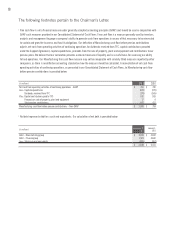E-Z-GO 2011 Annual Report Download - page 20
Download and view the complete annual report
Please find page 20 of the 2011 E-Z-GO annual report below. You can navigate through the pages in the report by either clicking on the pages listed below, or by using the keyword search tool below to find specific information within the annual report.
benefits, or potential losses on our Finance segment’s receivables;
Difficult conditions in the financial markets which may adversely impact our customers’ ability to fund or finance
purchases of our products; and
Continued volatility in the economy resulting in a prolonged downturn in the markets in which we do business.
Item 1A. RISK FACTORS
Our business, financial condition and results of operations are subject to various risks, including those discussed below, which may
affect the value of our securities. The risks discussed below are those that we believe currently are the most significant to our
business.
We have customer concentration with the U.S. Government; reduction in U.S. Government defense spending may adversely
affect our results of operations and financial condition.
During 2011, we derived approximately 31% of our revenues from sales to a variety of U.S. Government entities. Our revenues
from the U.S. Government largely result from contracts awarded to us under various U.S. Government defense-related programs.
The funding of these programs is subject to congressional appropriation decisions. Although multiple-year contracts may be
planned in connection with major procurements, Congress generally appropriates funds on a fiscal year basis even though a
program may continue for several years. Consequently, programs often are only partially funded initially, and additional funds are
committed only as Congress makes further appropriations. If we incur costs in excess of funds committed on a contract, we are
more at risk for non-reimbursement of those costs until additional funds are appropriated.
Mounting pressure for U.S. Government deficit reduction and reduced national spending have created an environment where
national security spending is being closely examined. In addition, the withdrawal of U.S. troops from Iraq and uncertainty
regarding the future level of U.S. military involvement in Afghanistan adds to the pressure to reduce defense spending. In August
2011, Congress passed the Budget Control Act of 2011 which committed the U.S. Government to significantly reduce the federal
deficit over ten years. Under the Budget Act, very substantial automatic spending cuts, including approximately $600 billion in
cuts to the U.S, defense budget over a nine year period, are scheduled to be triggered beginning in 2013. As a result, long-term
funding for various programs in which we participate, as well as future purchasing decisions by our U.S. Government customers,
could be reduced, delayed or cancelled. In addition, these cuts could adversely affect the viability of the suppliers and
subcontractors under our programs.
The reduction or termination of funding, or changes in the timing of funding, for U.S. Government programs in which we currently
provide, or propose to provide, products or services would result in a reduction or loss of anticipated future revenues and could
materially and adversely impact our results of operations and financial condition.
U.S. Government contracts may be terminated at any time and may contain other unfavorable provisions.
The U.S. Government typically can terminate or modify any of its contracts with us either for its convenience or if we default by
failing to perform under the terms of the applicable contract. In the event of termination for the U.S. Government’s convenience,
contractors are generally protected by provisions covering reimbursement for costs incurred on the contracts and profit on those
costs but not the anticipated profit that would have been earned had the contract been completed. A termination arising out of our
default could expose us to liability, including but not limited to, liability for re-procurement costs, and have an adverse effect on
our ability to compete for future contracts and orders. If any of our contracts are terminated by the U.S. Government whether for
convenience or default, our backlog and anticipated revenues would be reduced by the expected value of the remaining work under
such contracts. On those contracts for which we are teamed with others and are not the prime contractor, the U.S. Government
could terminate a prime contract under which we are a subcontractor, irrespective of the quality of our products and services as a
subcontractor. In addition, U.S. Government contracts generally require the contractor to continue to perform on the contract even
if the U.S. Government is unable to make timely payments; failure to continue contract performance places the contractor at risk of
termination for default. Any such event could result in a material adverse effect on our cash flows, results of operations and
financial condition.
As a U.S. Government contractor, we are subject to procurement rules and regulations as well as changes in the Department of
Defense (DoD) acquisition practices.
We must comply with and are affected by laws and regulations relating to the formation, administration and performance of U.S.
Government contracts. These laws and regulations, among other things, require certification and disclosure of all cost and pricing
data in connection with contract negotiation, define allowable and unallowable costs and otherwise govern our right to
reimbursement under certain cost-based U.S. Government contracts, and restrict the use and dissemination of classified
information and the exportation of certain products and technical data. Our U.S. Government contracts contain provisions that
allow the U.S. Government to unilaterally suspend or debar us from receiving new contracts for a period of time, reduce the value
of existing contracts, issue modifications to a contract, and control and potentially prohibit the export of our products, services and
9
Textron Inc. Annual Report • 2011 9
























